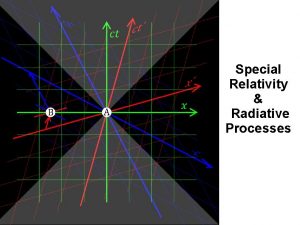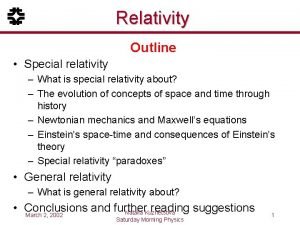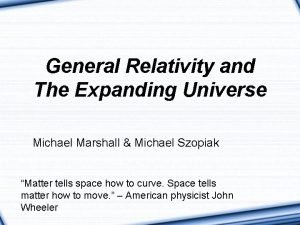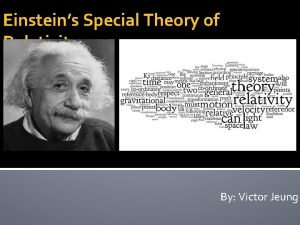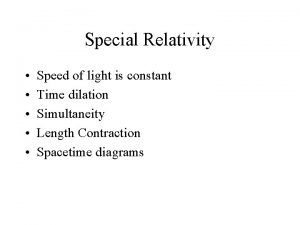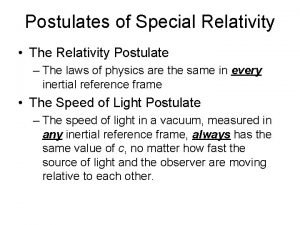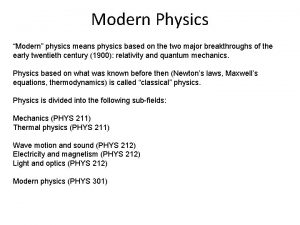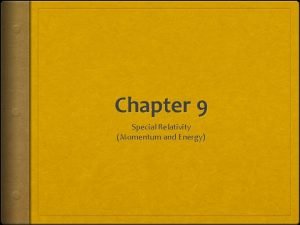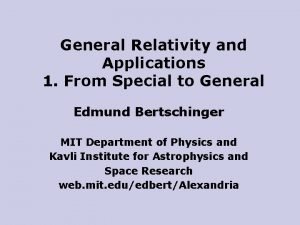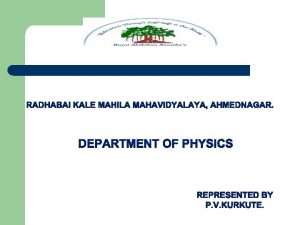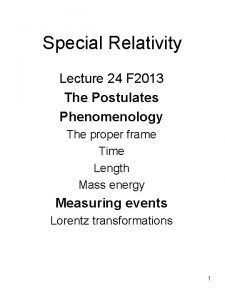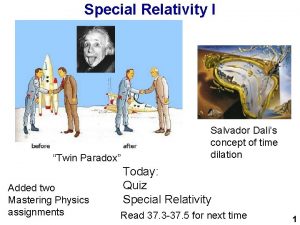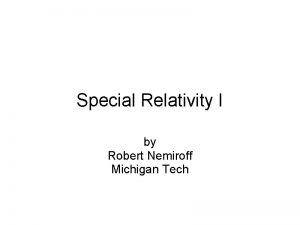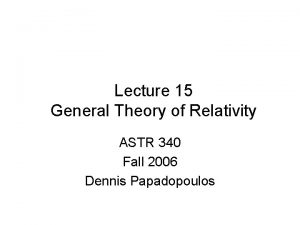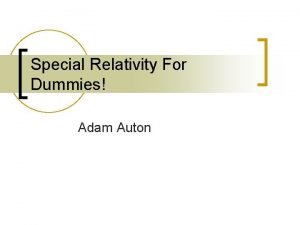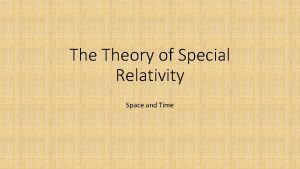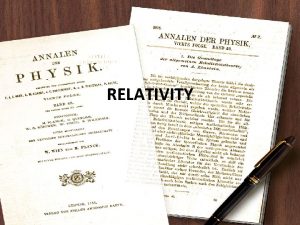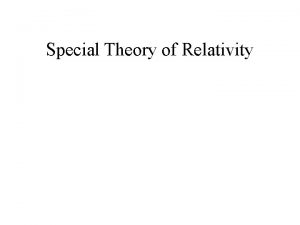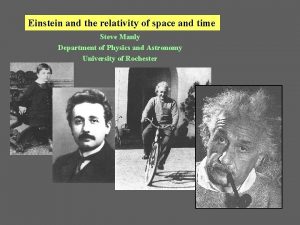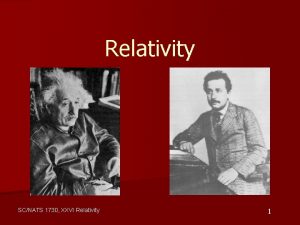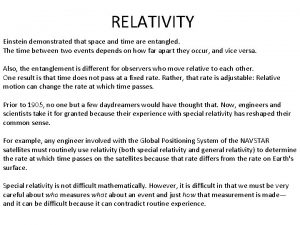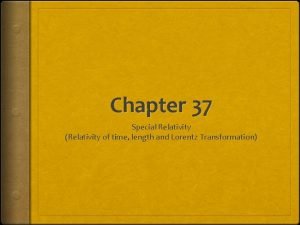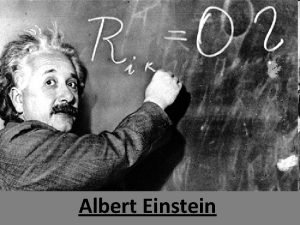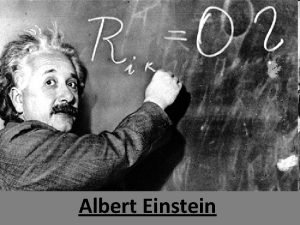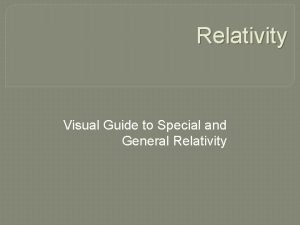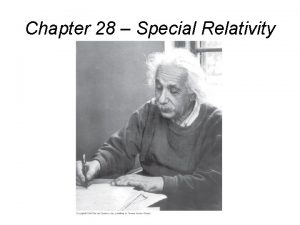Special Relativity Einstein messes with space and time


















- Slides: 18

Special Relativity Einstein messes with space and time

How Fast Are You Moving Right Now? 0 m/s relative to your chair n 400 m/s relative to earth center (rotation) n 30, 000 m/s relative to the sun (orbit) n 220, 000 m/s relative to the galaxy center (orbit) n n This is gist or main part of special relativity it’s the exploration of the physics of relative motion n only relative velocities matter: no absolute frame n very relevant comparative velocity is c = 300, 000 m/s n

A world without ether n For most of the 19 th century, physicists thought that space was permeated by “luminiferous ether” n n Michelson and Morley performed an experiment to measure earth’s velocity through this substance n n n this was thought to be necessary for light to propagate first result in 1887 Michelson was first American to win Nobel Prize in physics Found that light waves don’t bunch up in direction of earth motion n shocked the physics world: no ether!! speed of light is not measured relative to fixed medium unlike sound waves, water waves, etc.

Implications of speed of light is constant n Einstein pondered: what would be the consequences of a constant speed of light independent of state of motion (if at constant velocity) n any observer traveling at constant velocity will see light behave “normally, ” and always at the same speed n n Mathematical consequences are very clear forced to give up Newtonian view of space and time as completely separate concepts n provides rules to compute observable comparisons between observers with relative velocity n n thus “relativity”: means relative state of motion

Simultaneity is relative, not absolute Observer riding in spaceship at constant velocity sees a flash of light situated in the center of the ship’s chamber hit both ends at the same time But to a stationary observer (or any observer in relative motion), the condition that light travels each way at the same speed in their own frame means that the events will not be simultaneous. In the case pictured, the stationary observer sees the flash hit the back of the ship before the front

One person’s space is another’s time n If simultaneity is broken, no one can agree on a universal time that suits all n n Because the speed of light is constant (and finite) for all observers, space and time are unavoidably mixed n n the relative state of motion is important we’ve seen an aspect of this in that looking into the distance is the same as looking back in time Imagine a spaceship flying by with a strobe flashing once per second (as timed by the occupant) n n the occupant sees the strobe as stationary you see flashes in different positions, and disagree on the timing between flashes: space and time are mixed n n see description of light clock in text Space and time mixing promotes unified view of spacetime n “events” are described by three spatial coordinates plus time

The Lorentz Transformation n There is a prescription for transforming between observers in relative motion ct’ = (ct vx/c); x’ = (x vt); y ’ = y ; z’ = z n “primed” coordinates belong to observer moving at speed v along the x direction (relative to unprimed) n note mixing of x and t into x’ and t’ n time and space being nixed up n multiplying t by c to put on same footing as x n now it’s a distance, with units of meters n the (gamma) factor is a function of velocity:

The gamma ( ) factor n Gamma ( ) is a measure of how relativistic you are n When v = 0, = 1. 0 n n At v = 0. 6 c, = 1. 25 n n a little whacky At v = 0. 8 c, = 1. 67 n n and things are normal getting to be funky As v c,

What does do? n Time dilation: clocks on a moving platform appear to tick slower by the factor n n n at 0. 6 c, = 1. 25, so moving clock seems to tick off 48 seconds per minute standing on platform, you see the clocks on a fast-moving train tick slowly: people age more slowly, though to them, all is normal Length contraction: moving objects appear to be “compressed” along the direction of travel by the factor n n at 0. 6 c, = 1. 25, so fast meter stick will measure 0. 8 m to stationary observer standing on a platform, you see a shorter train slip past, though the occupants see their train as normal length

Why don’t we see relativity every day? n We’re soooo slow (relative to c), that length contraction and time dilation don’t amount to much n 30 m/s freeway speed has v/c = 10 -7 n = 1. 00000005 n 30, 000 m/s earth around sun has v/c = 10 -4 n = 1. 00005 n but precise measurements see this clearly

Velocity Addition n Also falling out of the requirement that the speed of light is constant for all observers is a new rule for adding velocities Galilean addition had that someone traveling at v 1 throwing a ball forward at v 2 would make the ball go at v 1+v 2 In relativity, reduces to Galilean addition for small velocities n can never get more than c if v 1 and v 2 are both c n if either v 1 OR v 2 is c, then vrel = c: light always is equal to c n


Classic Paradoxes n n The twin paradox: n one twin (age 30) sets off in rocket at high speed, returns to earth after long trip n if v = 0. 6 c, 30 years will pass on earth while only 24 will pass in high speed rocket n twin returns at age 54 to find sibling at 60 years old n why not the other way around? Pole-vaulter into barn n high-speed runner with 12 meter pole runs into 10 meter barn; barn door closes, and encompasses length-contracted 9. 6 m pole (at 0. 6 c) n but runner sees barn shrunken to 8 m, and is holding 12 m pole! n can the barn door close before the pole crashes through the

If I’m in a car, traveling at the speed of light… n n If I turn on my headlights, do they work? Answer: of course—to you, all is normal n you are in an un-accelerated (inertial) frame of reference n all things operate normally in your frame To the “stationary” outsider, your lights look weird n but then again, so do you (because you’re going so fast) n in fact, at the speed of light, all forward signals you send arrive at the same time you do And the outside, “stationary” world looks weird to you

What would I experience at light speed? n It is impossible to get a massive thing to travel truly at the speed of light energy required is mc 2, where as v c n so requires infinite energy to get all the way to c n n But if you are a massless photon… to the outside, your clock is stopped n so you arrive at your destination in the same instant you leave your source (by your clock) n n across the universe in a perceived instant n makes sense, if to you the outside world’s clock has stopped: you see no “ticks” happen before you hit

E = mc 2 as a consequence of relativity n Express 4 -vector as (ct, x, y, z) n describes an “event”: time and place n time coordinate plus three spatial coordinates n We’re always traveling through time n our 4 -velocity is (c, 0, 0, 0), when sitting still n moving at speed of light through time dimension n stationary 4 -momentum is p = mv (mc, 0, 0, 0) n for a moving particle, p = ( mc, px, py, pz) n where px, etc. are the standard momenta in the x, y, and z directions n the time-component times another factor of c is interpreted as energy n conservation of 4 -momentum gets energy and momentum

E= n 2 mc , continued can be approximated as = 1 + ½v 2/c 2 + …(small stuff at low velocities) n so that the time component of the 4 -momentum c is: m c 2 = mc 2 + ½mv 2 + … n the second part of which is the familiar kinetic energy n Interpretation is that total energy, E = m c 2 mc 2 part is ever-present, and is called “rest mass energy” n kinetic part adds to total energy if in motion n since sticks to m in 4 -momentum, can interpret this to mean mass is effectively increased by motion: m m n

Experimental Confirmation n We see time dilation in particle lifetimes n in accelerators, particles live longer at high speed n their clocks are running slowly as seen by us n seen daily in particle accelerators worldwide We see length contraction of the lunar orbit n squished a bit in the direction of the earth’s travel around the sun E = mc 2 extensively confirmed n nuclear power/bombs n sun’s energy conversion mechanism n particle accelerators
 Special relativity vs general relativity
Special relativity vs general relativity Postulates of special theory of relativity
Postulates of special theory of relativity General vs special relativity
General vs special relativity 2 postulates of relativity
2 postulates of relativity Albert einstein theory of special relativity
Albert einstein theory of special relativity When god messes up your plans
When god messes up your plans Special relativity
Special relativity Relativity postulates
Relativity postulates Define modern physics
Define modern physics Momentum special relativity
Momentum special relativity Special relativity higher physics
Special relativity higher physics Special relativity summary
Special relativity summary Postulates of special theory of relativity
Postulates of special theory of relativity Postulates of special theory of relativity
Postulates of special theory of relativity Special relativity
Special relativity Special relativity
Special relativity Postulates of special theory of relativity
Postulates of special theory of relativity Special relativity for dummies
Special relativity for dummies Time dilation theory of relativity
Time dilation theory of relativity
